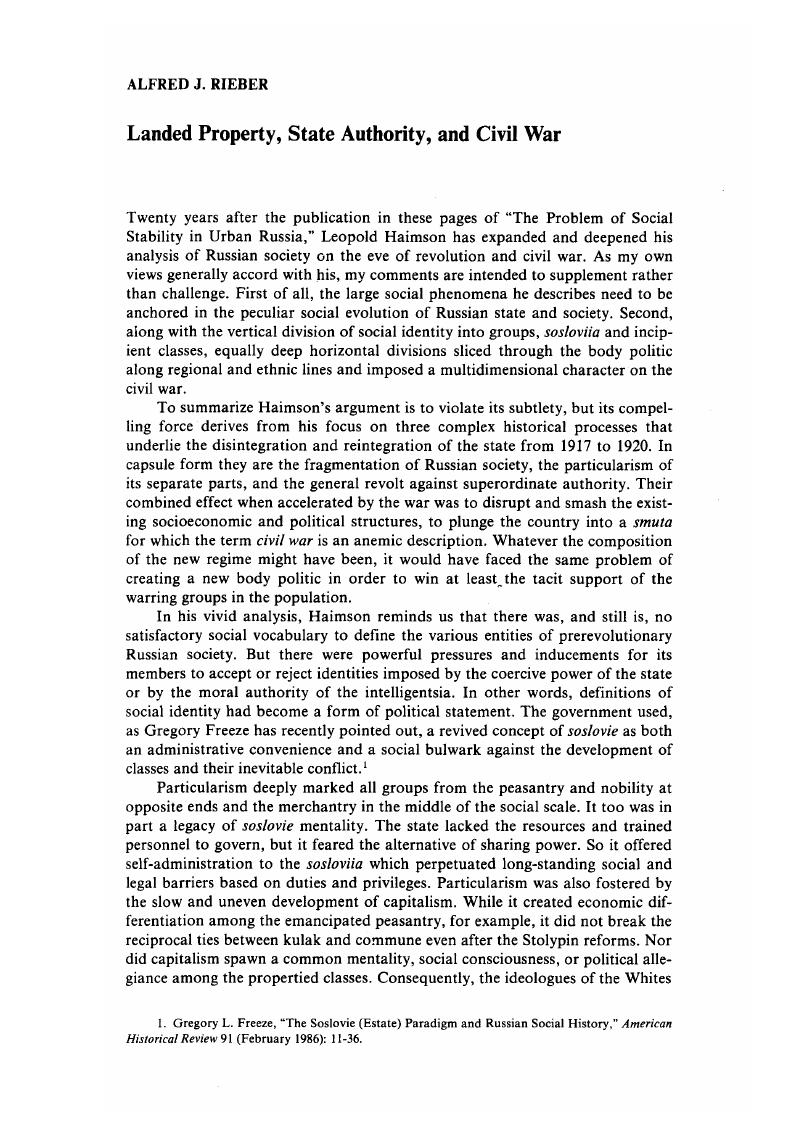Article contents
Landed Property, State Authority, and Civil War
Published online by Cambridge University Press: 27 January 2017
Abstract

- Type
- Discussion
- Information
- Copyright
- Copyright © Association for Slavic, East European, and Eurasian Studies. 1988
References
1. Freeze, Gregory L., “The Soslovie (Estate) Paradigm and Russian Social History,” American Historical Review 91 (February 1986): 11–36.CrossRefGoogle Scholar
2. Lewin, Moshe, The Making of the Soviet System: Essays in the Social History of Interwar Russia (New York: Pantheon, 1985), pp. 22–23, 191–192Google Scholar.
3. Bonnell, Victoria E., Roots of Rebellion: Workers Politics and Organization in St. Petersburgand Moscow, 1900–1914 (Berkeley: University of California Press, 1983).Google Scholar
4. Wortman, Richard, “Moscow and Petersburg: The Problem of Political Center in TsaristRussia, 1881–1914,” in Rites of Power: Symbolism, Ritual, and Politics since the Middle Ages, ed. Wilentz, Sean (Philadelphia: University of Pennsylvania Press, 1986), p. 268.Google Scholar
5. Rowney, Don Karl, “Organizational Change and Social Adaptation,” in Russian Officialdom: The Bureaucratization of Russian Society from the Seventeenth to the Twentieth Century, ed. Pintner, Walter M. and Rowney, Don Karl (Chapel Hill: University of North Carolina Press, 1980), p. 311.Google Scholar
6. Wildman, Allan K., The End of the Russian Imperial Army (Princeton, N.J.: Princeton University Press, 1980), p. 104.Google Scholar
7. Coquin, Francois-Xavier, La Siberie: Peuplement et immigration paysanne au XIXe siécle (Paris: Institute d'etudes slaves, 1969), p. 682.Google Scholar
8. Aziatskaia Rossiia (St. Petersburg, 1914) 1: 178–199, 383, diagrams following pp. 490 and 492
9. Brooks, Jeffrey, When Russia Learned to Read. Literacy and Popular Culture 1861–1917 (Princeton, N.J.: Princeton University Press, 1985)Google Scholar; Eklof, Ben, Russian Peasant Schools. Officialdom, Village Culture and Popular Pedagogy, 1861–1914 (Berkeley: University of California Press, 1986 Google Scholar.
10. Kenez, Peter, Civil War in South Russia, 1919–1920, (Berkeley: University of California Press, 1977).Google Scholar
11. Svatnikov, S. G., Rossiia i Don (Vienna: Donskoi istoricheskoi komissii, 1924), p. 572.Google Scholar
12. Krasnov, P. N., “Vsevelikoe voisko donskoe,” Arkhiv russkoi revoliutsii, (Berlin, 1922) 5:Google Scholar
13. Koblov, la., O tatarizatsii inorodtsev Privolzhskogo kraia (Kazan, 1910)Google Scholar; Edelman, Robert, Gentry Politics on the Eve of the Russian Revolution: The Nationalist Party 1907–1917 (New Brunswick, N.J.: Rutgers University Press, 1980)Google Scholar; Riabushinskii, V. P., Velikaia Rossiia: Sbomik stateipo voennymi obshchestvennym voprosam, 2 volumes (Moscow, 1911)Google Scholar; Utro Rossii, 5, 6, 7 November and 2 December1914.
14. Blank, Stephen, “The Struggle for Soviet Bashkiriia 1917–1923,” Nationality Papers 10 (Spring 1983): 1–26 Google Scholar. For a similar pattern in Turkestan see idem, “The Contested Terrain: Muslim Political Participation in Soviet Turkestan, 1917–1920,” Central Asian Survey, forthcoming.
15. For Makhno, and Antonov, , Radkey, Oliver, The Unknown Civil War in Russia (Stanford, Calif.: Stanford University Press, 1976)Google Scholar; for the Black Sea N. Voronovich, Republic, “Mezh dvukhognei,” Arkhiv russkoi revoliutsii 7: 109–110 Google Scholar.
- 5
- Cited by




